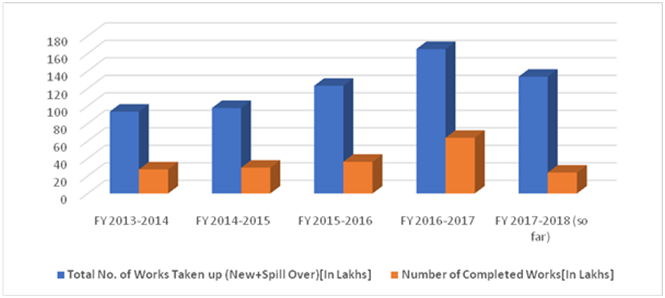GENERAL STUDIES PAPER 2
Topic: Governance and Welfare
Note on MGNREGA
Context:
- MGNREGA Scheme has seen major changes in the last two years.
Objective of MGNREGA
- Strengthening the livelihood resource base of the poor is one of the main objectives of MGNREGS.
- Apart from meeting the demand for wage employment on the ground, the government is laying stress on strengthening the livelihood resource base of the poor and the vulnerable.
Keypoints:
- Use of ICT tools, space technology, focus on improving livelihood resource base of people, provision of diversified livelihood opportunities through convergent programme implementation are some of the major features of changes brought in programme management.
- Measure like electronic fund management system (eFMS), Aadhaar seeding, Geo tagging of assets and strengthening of Social Audit System are some steps towards bringing in more transparency and accountability in the programme implementation.
- The current Financial Year is marked by the highest ever budget allocation of Rs. 48000 Cr.
- The table below gives a glimpse of the revised estimate at the Centre’s level and the expenditure in the States/UTs over the last 7 years. The Government is committed to provide funds for implementation of MGNREGA.
|
Year |
Revised (Cr) |
Expenditure (Cr) |
|
2011-12 |
31,000.00 |
37,072.82 |
|
2012-13 |
30,287.00 |
39,778.29 |
|
2013-14 |
33,000.00 |
38,511.10 |
|
2014-15 |
33,000.00 |
36,025.04 |
|
2015-16 |
37,345.95 |
44,006.56 |
|
2016-17 |
48,220.26 |
57,946.72 |
|
2017-18* |
48,000.00 |
35,436.92 |
* Figures as on 12.09.2017
- To ensure that MGNREGA workers receive their wages on time, National Electronic Fund Management System (NeFMS) has been put in place.
- Almost 96% of wages are being paid directly to the beneficiaries’ bank accounts.
- Strengthened the monitoring system to meet the objectives effectively.
- This intense monitoring and fixing accountability for delays in payments has shown significant result in the current financial year.
- Around 85% of the wages are being paid to the workers in time.
- This is almost double the percentage in comparison with last FY as can be seen in the graph below:

- Through a bottom-up participatory approach, every year the Gram Panchayats (GPs) prepare the shelf of works to be executed in the next financial year.
- These works are taken up considering the 155 permissible activities under the Scheme, which are revised periodically depending upon State requests.
- The Centre safeguards the decisions of the local bodies through its emphasis on creation of shelf of projects in the GPs and in no way attempts to undermine their authority.

- Completed works have been geo tagged and made available in public domain improving and enhancing transparency in programme management. More than 2 Cr assets have been geo tagged so far.
- The Ministry has made it mandatory to geo tag three stages of an asset creation.
- In order to optimize public investments, adequate focus is also being laid on convergence of MGNREGS with other schemes.
- Ministry is trying to ensure gainful and proper utilization of funds along with provision of wage employment seeking work.
- A good example of convergence is houses being constructed under Pradhan Mantri Awas Yojana (PMAY).
- While 33 Lakhs houses were constructed in FY 2016-17 with Rs. 18000 from MGNREGS as unskilled wage labour contribution to every house, the current financial year’s target is 51 lakh PMAY houses.
- Besides, MGNREGA provides Rs. 12000 for construction of household latrines in every PMAY house.
- Large scale training of Self-Help Group women as Village Resource Persons for social audit is being undertaken.
- All initiatives under MGNREGS have been taken in consultation with the States and UTs.
- Multiple assets to a household for augmentation of livelihood potential is a major thrust under MGNREGS.
Topic: Welfare programs, Health and sanitation
‘Swachhta Hi Sewa’ campaign jointly launched by NDMC and DoPT
Context:
- The New Delhi Municipal Council (NDMC) in association with Department of Personnel and Training (DoPT) launched the fortnight long ‘Swachhta Hi Sewa’ cleanliness campaign.
Keypoints:
- The NDMC for the entire Municipality area under its jurisdiction being declared an entirely Open Defecation Free (ODF).
- ‘Swachhta Hi Sewa’ campaign was announced by the Prime Minister Shri Narendra Modi in the Mann ki Baat programme.
- As he said this cleanliness campaign should not be viewed as an NDMC campaign, but as a mass movement.
- Minister appealed that cleanliness as a habit should not be limited during this 15-day campaign, but should become an everyday activity.
- The DoPT is moving vigorously towards 100% implementation of e-office which will result in reduced paper consumption and less garbage.
- An eco-friendly system to convert bio-waste into manure has been installed in the DoPT Canteen in North Block.
- Sanitary napkin disposal machines will be installed in all Ladies Washrooms for better hygiene.
- DoPT employees will also be offering Shramdan by undertaking tree plantation drive at Vinay Marg playground during this pakhwada.
- To spread awareness among employees, DoPT will distribute T-shirts and caps with the Swachh Bharat Mission logo.
GENERAL STUDIES PAPER 3
Topic: Science and Technology
Successful Development Trials of Astra Missile
Context:
- The final Development Flight Trials of Astra – Beyond Visual Range Air to Air Missile (BVRAAM) were successfully conducted over the Bay of Bengal, Off the Coast of Chandipur, Odisha.
Keypoints:
- A total of seven trials were conducted against Pilotless Target Aircrafts (PTA) successfully.
- The missions included engagement of target at very long range, engagement of high manoeuvring target at medium range and multiple launches of missiles in salvo to engage multiple targets.
- All the sub-systems including the indigenous RF Seeker performed accurately, meeting all the mission parameters and objectives.
- Two missiles were also launched in the combat configuration with warhead and the targets were neutralized.
Comments